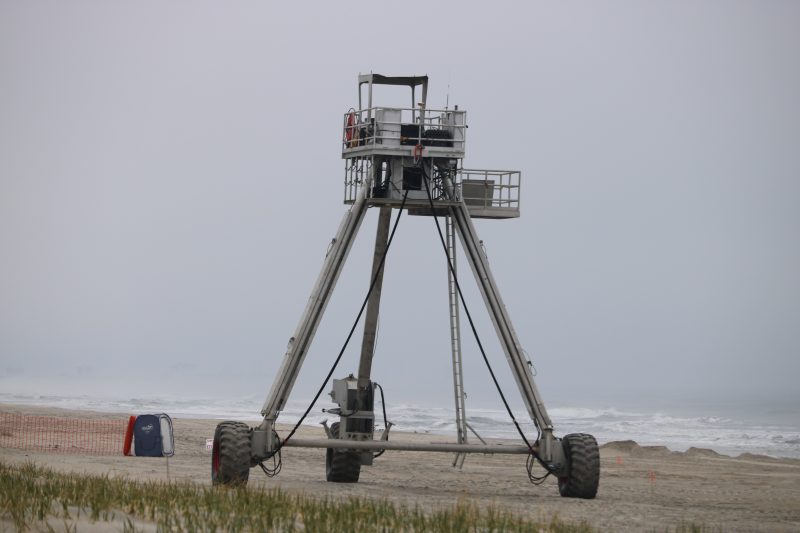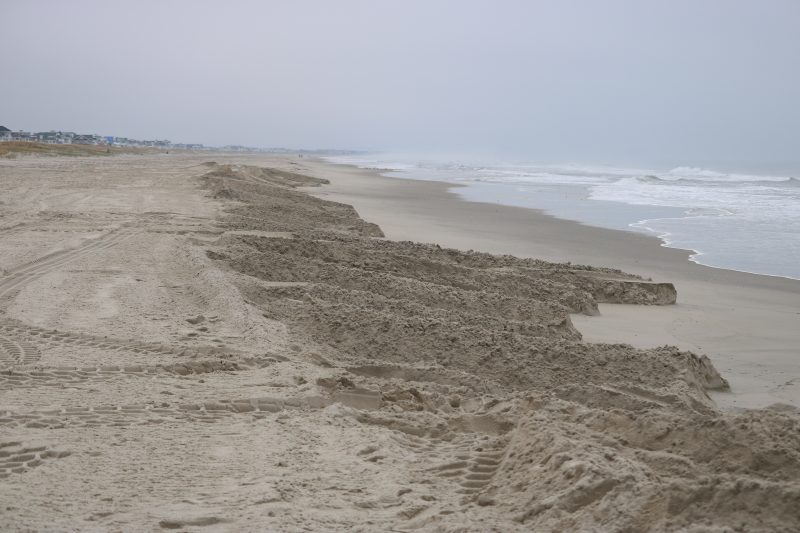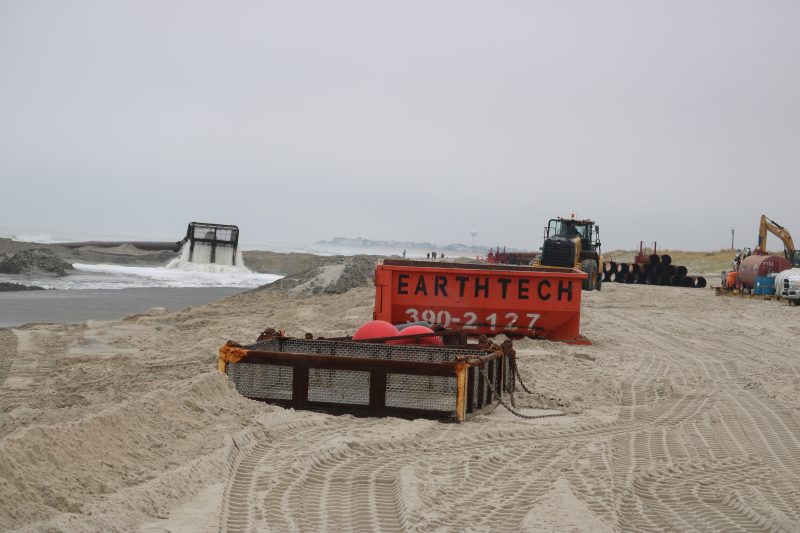New sand is deposited on the beach between 56th and 57th streets.
 By DONALD WITTKOWSKI
By DONALD WITTKOWSKI
A veritable army of bulldozers, excavators, temporary buildings and workers wearing hard hats has taken over a stretch of Ocean City’s south end beaches normally deserted in December.
If you think that’s strange, there’s also a towering, three-legged contraption known as a “CRAB” that looks like something straight out of an alien invasion movie.
But don’t fear. All of the heavy machinery is part of a project to replenish Ocean City’s eroded beaches between 45th Street and 59th Street with 257,000 cubic yards of new sand.
The CRAB will play a key role in the beach replenishment project. Moving along both in the water and on land, it deploys instruments on the bottom of the ocean, collecting data to monitor the progress of the project.
CRAB stands for “Coastal Research Amphibious Buggy.” The massive piece of machinery stands 33 feet high and lurches along the sand at speeds of up to 6 mph while surveying the beaches.

The towering "CRAB" plays an important role in the project.
The replenishment project will widen the south end beaches to create an even larger barrier of sand to protect homes, businesses and other property during coastal storms. It will also have the aesthetic value of making the beaches more attractive for the legions of tourists who visit Ocean City in the summer.
In addition to restoring the beaches with fresh sand, the project will also improve the dune crossovers and access paths. New fencing and other features will be installed or repaired as another facet of the work.
“This work allows a healthy dune system to grow and to protect property throughout Ocean City,” Mayor Jay Gillian said in a statement about the overall benefits of the project.
Gillian noted the project is expected to take a couple of weeks to complete. The work got underway Friday on the beach between 56th and 57th streets and was going strong Saturday.
As a safety precaution, a 1,000-foot section of beach will be closed to public access at any given time as work progresses northward heading toward 45th Street, Gillian said.
“Thank you for your patience and understanding as this important project continues,” he said to the public in his statement.
https://www.youtube.com/watch?v=QuZHuRnjBLc
Great Lakes Dredge & Dock Co. is the contractor hired by the U.S. Army Corps of Engineers to perform the beachfill work.
Ocean City’s south end is part of a $33.7 million beach replenishment project supervised by the Army Corps of Engineers that will also include neighboring Strathmere and Sea Isle City. Strathmere will go next, and the project is expected to wrap up in Sea Isle by next spring.
Altogether, more than 1.3 million cubic yards of new sand will be pumped onto the Ocean City, Strathmere and Sea Isle beaches to restore the storm-eroded shoreline.
“Work is designed to maintain the dune and berm system in the communities and reduce the risk of storm damages to coastal infrastructure,” the Army Corps said in a news release.
The Strathmere beaches will be replenished with 456,000 cubic yards of sand from Corson’s Inlet to about Jasper Road.
In Sea Isle, 252,000 cubic yards of sand will be placed on the beach from 29th Street to 53rd Street and another 388,000 cubic yards will restore the beaches from 73rd Street to Townsends Inlet.

New sand is deposited on the beach between 56th and 57th streets.
A large, barge-like dredge anchored offshore is taking sand from the bottom of Corson’s Inlet and pumping it onto the beaches through a network of massive pipes.
Bulldozers working in tandem near the water line were spreading the sand Saturday on the Ocean City beach between 56th and 57th streets. Already, parts of the beach in this area are wider and topped with a thick layer of powdery sand.
Ocean City and other shore communities have a partnership with the Army Corps of Engineers and the New Jersey Department of Environmental Protection to periodically replenish the beaches and dunes to keep them in good condition for storm protection.
Beach replenishment projects are primarily funded by the federal government through the Army Corps of Engineers.
Under the funding formula, the federal government kicks in 65 percent of the cost, while the NJDEP and the towns that are getting their beaches replenished subdivide the remaining 35 percent.

The beach at 56th Street is crowded with equipment for the project.
 By DONALD WITTKOWSKI
A veritable army of bulldozers, excavators, temporary buildings and workers wearing hard hats has taken over a stretch of Ocean City’s south end beaches normally deserted in December.
If you think that’s strange, there’s also a towering, three-legged contraption known as a “CRAB” that looks like something straight out of an alien invasion movie.
But don’t fear. All of the heavy machinery is part of a project to replenish Ocean City’s eroded beaches between 45th Street and 59th Street with 257,000 cubic yards of new sand.
The CRAB will play a key role in the beach replenishment project. Moving along both in the water and on land, it deploys instruments on the bottom of the ocean, collecting data to monitor the progress of the project.
CRAB stands for “Coastal Research Amphibious Buggy.” The massive piece of machinery stands 33 feet high and lurches along the sand at speeds of up to 6 mph while surveying the beaches.
By DONALD WITTKOWSKI
A veritable army of bulldozers, excavators, temporary buildings and workers wearing hard hats has taken over a stretch of Ocean City’s south end beaches normally deserted in December.
If you think that’s strange, there’s also a towering, three-legged contraption known as a “CRAB” that looks like something straight out of an alien invasion movie.
But don’t fear. All of the heavy machinery is part of a project to replenish Ocean City’s eroded beaches between 45th Street and 59th Street with 257,000 cubic yards of new sand.
The CRAB will play a key role in the beach replenishment project. Moving along both in the water and on land, it deploys instruments on the bottom of the ocean, collecting data to monitor the progress of the project.
CRAB stands for “Coastal Research Amphibious Buggy.” The massive piece of machinery stands 33 feet high and lurches along the sand at speeds of up to 6 mph while surveying the beaches.

 New sand is deposited on the beach between 56th and 57th streets.
A large, barge-like dredge anchored offshore is taking sand from the bottom of Corson’s Inlet and pumping it onto the beaches through a network of massive pipes.
Bulldozers working in tandem near the water line were spreading the sand Saturday on the Ocean City beach between 56th and 57th streets. Already, parts of the beach in this area are wider and topped with a thick layer of powdery sand.
Ocean City and other shore communities have a partnership with the Army Corps of Engineers and the New Jersey Department of Environmental Protection to periodically replenish the beaches and dunes to keep them in good condition for storm protection.
Beach replenishment projects are primarily funded by the federal government through the Army Corps of Engineers.
Under the funding formula, the federal government kicks in 65 percent of the cost, while the NJDEP and the towns that are getting their beaches replenished subdivide the remaining 35 percent.
New sand is deposited on the beach between 56th and 57th streets.
A large, barge-like dredge anchored offshore is taking sand from the bottom of Corson’s Inlet and pumping it onto the beaches through a network of massive pipes.
Bulldozers working in tandem near the water line were spreading the sand Saturday on the Ocean City beach between 56th and 57th streets. Already, parts of the beach in this area are wider and topped with a thick layer of powdery sand.
Ocean City and other shore communities have a partnership with the Army Corps of Engineers and the New Jersey Department of Environmental Protection to periodically replenish the beaches and dunes to keep them in good condition for storm protection.
Beach replenishment projects are primarily funded by the federal government through the Army Corps of Engineers.
Under the funding formula, the federal government kicks in 65 percent of the cost, while the NJDEP and the towns that are getting their beaches replenished subdivide the remaining 35 percent.
 The beach at 56th Street is crowded with equipment for the project.
The beach at 56th Street is crowded with equipment for the project.